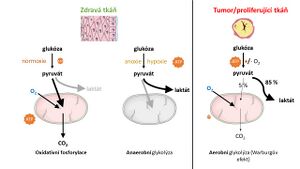Warburg effect
The Warburg effect refers to the specific metabolism of tumor cells, which have less functional mitochondria and significantly reduced oxidative phosphorylation compared to healthy cells. Here, ATP synthesis is compensated glycolytically with the simultaneous formation of lactate. The synonymous term for Warburg effect is aerobic glycolysis[1][2].

First half of the 20th century[edit | edit source]
In 1924 the German scientist Otto H. Warburg[4] described this tumor phenotype in a somewhat simplified concept. The similar thing was observed by Herbert G. Crabtree in yeast. He even confirmed that in case of an excess of glucose or fructose, there will be a temporary inhibition of respiration. Later, he decided to verify Warburg's claim not only on tumor cells, but also on various tissues. Crabtree concluded the work by stating that aerobic glycolysis is not the domain of malignant cells only, but is inherent to any increased pathological proliferation[5]. Further experiments then led Crabtree to hypothesize that oxidative phosphorylation is key to the progression of specific tumors and that it is not possible to simply describe the metabolism of tumor tissue as predominantly glycolytic[6].
Warburg's uniqueness lies in the fact that he was the first to understand the importance of oxidation and reduction metabolic pathways in living organisms and was able to place them in the right context. He recieved the Nobel Prize for his work in 1931 [1].
The hypothesis of non-functional or less functional mitochondria was only confirmed in 1951 by Feodor Lynen. In the 1950s, it was already possible to quantify the extent of oxidative phosphorylation and glycolysis, which prompted Otto Warburg, then director of the Max Planck Institute, to write a new summary paper[7]. There he publishes a timeless hypothesis: "Energy itself will be the center of our thinking." Warburg already saw the weakness of tumor cells in the fact that they will use everything (not only glycolysis, but also oxidative phosphorylation, for example) to cover the enormous need for ATP.
The end of the 20th and the beginning of the 21st century[edit | edit source]
In the second half of the 20th century, a number of scientific groups focused on the possibility of using the Warburg effect as a target for antitumor therapy. The task was to selectively inhibit glycolysis and thus induce cell death. It turned out that it is not that simple, although it was possible to identify a number of pathological changes in the mitochondria of tumor cells[8]. contributed to the modern perception of tumor metabolism only in 2004, Rodrigue Rossignol, who showed that the availability of energy substrates can change not only the oxidative capacity of tumor cells, but also the morphology of their mitochondria[9]. Further studies have shown that tumor cells work on the principle of so-called metabolic remodeling. A number of solid tumor cells proliferate very quickly. At the same time, however, the malignant tissue does not manage to vascularize quickly enough. In similar cases, there is a temporary lack of substrates of oxidative phosphorylation or glycolysis. Not infrequently, there is also a decrease in oxygen concentration, which complicates the whole matter even more (see Reductive carboxylation)[10].
Source[edit | edit source]
References[edit | edit source]
- ↑ has also been adopted for the Warburg effect. SINGH, – COSTELLO, Leslie. Mitochondria and Cancer. - edition. Springer Science & Business Media, 2009. 289 pp. ISBN 9780387848358.
- ↑ WEINHOUSE, Sidney. On Respiratory Impairment in Cancer Cells. Science. 1956, y. 3215, vol. 124, p. 267-269, ISSN 0036-8075. DOI: 10.1126/science.124.3215.267.
- ↑ WANDER HEIDEN, MG et al.. Understanding the Warburg Effect: The Metabolic Requirements of Cell Proliferation. Science. 2009, y. 324, vol. 5930, p. 1029 - 1033, ISSN 0036-8075. DOI: 10.1126/science.1160809.
- ↑ WARBURG, Otto et al.. Metabolism of carcinoma cells. Biochem Z. 1924, y. 152, vol. -, p. 309 - 344, DOI: -.
- ↑ CRABTREE, HG. The carbohydrate metabolism of certain pathological overgrowths. Biochem J. 1928, y. 22, vol. 5, p. 1289-98, ISSN 0264-6021. DOI: 10.1042/bj0221289.
- ↑ CRABTREE, HG. Observations on the carbohydrate metabolism of tumours. Biochem J. 1929, y. 23, vol. 3, p. 536-545, ISSN 0264-6021. DOI: 10.1042/bj0230536.
- ↑ WARBURG, Otto. On the Origin of Cancer Cells. Science. 1956, y. 123, vol. 3191, p. 309-314, ISSN 0036-8075. DOI: 10.1126/science.123.3191.309.
- ↑ DIAZ-RUIZ, R.. Tumor cell energy metabolism and its common features with yeast metabolism. Biochimica et Biophysica Acta (BBA). 2009, y. 1796, vol. 2, p. 252-265, ISSN 0304-4165. DOI: 10.1016/j.bbcan.2009.07.003.
- ↑ ROSSIGNOL, Rodrigue et al.. Energy Substrate Modulates Mitochondrial Structure and Oxidative Capacity in Cancer Cells. Cancer Research. 2004, y. 64, vol. 3, p. 985 - 993, ISSN 00085472. DOI: 10.1158/0008-5472.CAN-03-1101.
- ↑ SMOLKOVÁ,. The Role of Mitochondrial NADPH-Dependent Isocitrate Dehydrogenase in Cancer Cells. International Journal of Cell Biology. 2012, y. 2012, vol. xxx, p. 0 - 12, ISSN 1687-8884. DOI: 10.1155/2012/273947.
